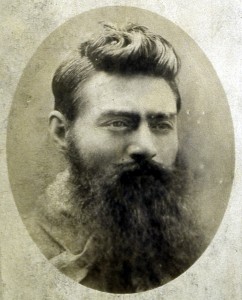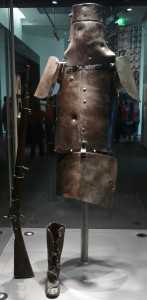 Australian bushranger, bank robber, cop killer and folk hero Ned Kelly was executed in 1880 at Old Melbourne Gaol. As a condemned prisoner, his body was given to science for dissection. After the doctors were done with him, his body was buried in an unmarked mass grave on the Old Melbourne grounds. His head was given to phrenologists to study, then returned to the police who used it as a paperweight. When Old Melbourne Gaol was closed in 1929, the mass grave was opened and the remains transferred to Pentridge Prison and reinterred.
Australian bushranger, bank robber, cop killer and folk hero Ned Kelly was executed in 1880 at Old Melbourne Gaol. As a condemned prisoner, his body was given to science for dissection. After the doctors were done with him, his body was buried in an unmarked mass grave on the Old Melbourne grounds. His head was given to phrenologists to study, then returned to the police who used it as a paperweight. When Old Melbourne Gaol was closed in 1929, the mass grave was opened and the remains transferred to Pentridge Prison and reinterred.
During the move, workers took parts they thought had belonged to Ned Kelly, including a skull. They turned out to belong to an Ernest Knox, executed and buried in 1894, but the site foreman sent the skull to the Australian Institute of Anatomy in Canberra thinking it was Kelly’s. Meanwhile, the skull that the police had been cheerfully desecrating for years also wound up in the Australian Institute of Anatomy in Canberra. It was put on display until stolen in 1978. It turned up again in 2009 but when tested turned out not to be Ned’s head at all — it might have belonged to Frederick Deeming, one of many Jack the Ripper suspects — so it seems the skulls were switched at some point when it was on display or perhaps even earlier when it was bouncing around the police station.
With all this body parts confusion, the location of Ned Kelly’s remains has been something of a mystery. Inspired by the surfacing of the possible Kelly skull, in 2008 archaeologists found a mass grave on the site of Pentridge Prison. The remains of 32 bodies were jumbled in the pit, so even if they had found the spot they hadn’t found Ned Kelly yet.
Now, 131 years after his death, Ned Kelly’s remains have been conclusively identified by researchers at the Victorian Institute of Forensic Medicine.
To confirm whether the 25-year-old Kelly’s skeleton was among the remains stored in the mortuary, scientists took DNA samples from each set of remains. Each DNA profile generated was then compared with mitochondrial DNA – the best tool to establish connections across generations – extracted from the blood of Melbourne art teacher Leigh Olver, a great-grandson of Kelly’s sister Ellen.
The results could not have been clearer. ”Leigh Olver’s mitochondrial DNA is the same as Ned Kelly’s,” institute director Stephen Cordner said yesterday. ”Among a grave of 24 unidentified people believed to include Ned Kelly is a set of human remains … bones which have a mitochondrial DNA profile the same as Leigh Olver’s and therefore Ned Kelly.”
But there was more to come. The project’s scientific leader David Ranson said it was unlikely Kelly’s wish for his body to remain untouched after death was granted, as the ”saw cut” marks on the neck vertebra are consistent with a post mortem examination.
 Osteological examination of the remains also uncovered gunshot injuries that match the ones Ned Kelly is known to have sustained in the shootout at the Glenrowan Inn that resulted in his arrest. Although he and his gang had some magnificent handmade armor made, with Biblical poetry, from plow blades forged over brush fires into helmets, breast plates, back plates and aprons, some police bullets still managed to meet their target. Prison doctor Andrew Shields, who examined Kelly before his execution, wrote up detailed descriptions of the injuries. Just as Shields had described, forensic anthropologists found a bullet hole in his right shin with bullet fragments still embedded inside, a healing gunshot injury on the left elbow, and a fractured right toe with shrapnel.
Osteological examination of the remains also uncovered gunshot injuries that match the ones Ned Kelly is known to have sustained in the shootout at the Glenrowan Inn that resulted in his arrest. Although he and his gang had some magnificent handmade armor made, with Biblical poetry, from plow blades forged over brush fires into helmets, breast plates, back plates and aprons, some police bullets still managed to meet their target. Prison doctor Andrew Shields, who examined Kelly before his execution, wrote up detailed descriptions of the injuries. Just as Shields had described, forensic anthropologists found a bullet hole in his right shin with bullet fragments still embedded inside, a healing gunshot injury on the left elbow, and a fractured right toe with shrapnel.
Next up for Ned: burial in a marked grave. His descendants will get to make the decision of where Ned Kelly’s remains will find their eternal rest at last, but politicians are antsy about it because of course his grave will be an enormous tourist draw. The town of Greta in Victoria, an area known as “Kelly Country” because it’s the family bought a large parcel of land after Ned’s Irish convict father died, is hoping Ned will be buried in the same cemetery where his mother, uncle and cousin are buried.
Burial in a marked grave will be essential! The state has paid squillions of dollars to get the science right and it would be absurd if they then threw the bones back into the ground again.
If politicians are antsy about it because they fear the grave will be an enormous tourist draw, so what? Are they afraid that the Kelly family wasn’t shown justice by the police, courts and government of the day? Do they find that 19th century capital punishment was immoral? IT WAS!
I think they’re antsy in a good way, meaning officials would love to have a tourist draw like Ned Kelly’s grave infusing much-needed tourist dollars into the local economy.
How did NK achieve that really great (if slightly meringue-like) hairdo in the Australian outback before the days of gel and mousse? But if he could improvise armor, curling irons would have been a piece of cake. When NK is reinterred, I wonder if Mick Jagger will attend the ceremony?
Ned Kelly’s a Dapper Dan man! (You’ve seen Oh Brother, Where Art Thou?, I hope.)
They had pomade in Ned’s day. It was usually made out of some sort of saturated fat and/or beeswax. Whatever it was had excellent hold.
Hels-You raise an important, if far from easy, question! What should we do with the bones of Ned Kelly – or anyone else, for that matter? Do we conveniently “lose” them (which is what seems to happen most often)? Do we lock them away in a research institution? Do we put them on display in a museum -inevitably “trivializing” them and disrespecting “their own culture and beliefs”? This is an issue that many museums (the National Museum in Cairo, the Museum of Man in Paris and the Museum of the American Indian in Washington…just to begin the list) are now wrestling with. I have been dancing around this disquieting problem in the latest post on my own blog. Ed G.
It’s a complex issue. I’m glad that indigenous peoples are increasingly seeing the remains of their relatives returned from creepy Victorian anthropological exhibits, and even when the remains are ancestral I still err on the side of cultural standards.
The recent implementation of reburial standards in the UK is more problematic to me. Archaeologists have to rebury any human remains, no matter how old, within two years of excavation. That’s not much time for detailed analysis.
Thank you Goldberg for the good laugh ~ This was so well written, kuddos to you, history blog man. Maybe we should just do what the Americans did with Bin Laden…similar to Goldberg’s suggestion…we just conveniently “lose” the body in the ocean to be eaten away by the likes of sponge bob square pants! :chicken:
i have been doing a esay on ned kelly
How’s it going?
:skull: hey man wad up?
Ned Kelly’s remains buried in unmarked grave
https://www.abc.net.au/news/2013-01-20/ned-kellys-remains-buried/4472996